Archive for the ‘Featured’ Category
Tuesday, May 19th, 2015
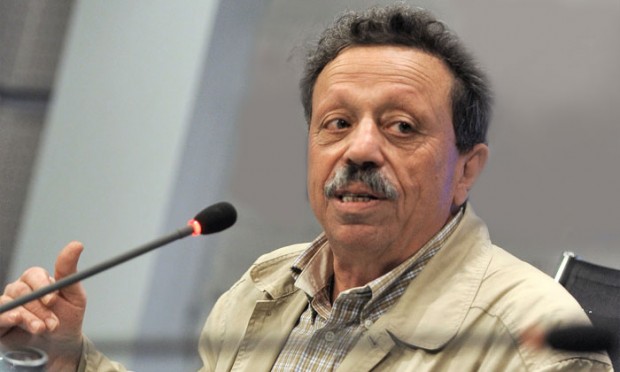
Israel Shamir is a Russian-born Jew who converted to Orthodox Christianity. Norman Finkelstein said of Shamir: “He has invented his entire personal history. Nothing he says about himself is true.”
Warren B. Routledge, author of the new unauthorized biography of Elie Wiesel, Holocaust High Priest, has thankfully CORRECTED some statements made by Israel Shamir in an email to Michael Santomauro referring to my May 11 interview with Routledge. The Shamir comment was posted at Santomauro’s Reporter Notebook Yahoo Group.
Shamir wrote that he knew Wiesel had spent time in Auschwitz because “a good personal friend, a French writer Piotr Ravich (spelling?),” said he did. It doesn’t seem to bother Shamir that this is hearsay, nor that he doesn’t know the spelling of his good, personal friend’s last name! He made some other errors of fact in his email. Here is the full text:
From: <[email protected]> on behalf of Israel Shamir [email protected] [ReportersNotebook]
Sent: Thursday, May 14, 2015 1:00 AM
To: [email protected]
Subject: Re: Listen to The Heretics’ Hour Monday night
There are many funny and dubious points about Wiesel, but he definitely was an inmate in Auschwitz. I had a good personal friend, a French writer Piotr Ravich (spelling?), who won the prix Goncourt. He committed suicide in 1970s, was a wonderful man, quite cheerful. So this Piotr Ravich had spent four years in Auschwitz, as much as anybody, and he knew Wiesel there. They belonged to the elite of the prisoners. Ravich was a translator and interpreter for the administration. Anyway Wiesel was there.
Mauriac played a very important part in Wiesel career, I do not know whether he lusted after him and I do not know whether Wiesel was a gay, but Mauriac’s Catholic faith played a very important part in the story. This is well described in many texts.
I next heard from Warren Routledge informing me that Shamir had made a number of errors in what he had written, and he, Routledge, intended to answer him. Here is Routledge’s response:
This is a follow-up to Israel Shamir’s friendly post in response to Frank Scott’s negative comments about my unauthorized biography of Elie Wiesel, entitled Holocaust High Priest.
I would just like to add a few comments to what Shamir wrote. His statement that his friend, Piotr Rawicz, “knew Wiesel there,” [Auschwitz] and the assurance he gives us that “Wiesel was there” [Auschwitz] are simply not true.
It is possible, however, that Wiesel and Rawicz could have met at some point, however briefly, after the war, when they had each established themselves in the mainstream media as Holocaust camp veterans within just a few years of each other.
Ravicz published his one and only novel Le Sang du ciel, a modernist work in the surrealist vein, in 1961, and received the Rivarol Prize (awarded to a writer born in a linguistic framework other than French) for it in 1962. Shamir also states erroneously that Rawicz received the highly-prestigious Goncourt Prize, which is not the case. Wiesel published La Nuit in 1958 and he also received the Rivarol Prize in 1963 for that work and several other short novels published in the early 1960s.
Each first novel was translated into English, Wiesel’s as Night in 1960, with another one, by his wife in 2006, which is discussed in great detail in my book. Likewise, Rawicz’s novel was translated as Blood from the Sky in 1964, with another, completely separate, translation in 2004.
Shamir states that Rawicz spent “four years at Auschwitz, as much as anybody,” yet Rawicz and his commentators actually only make claims for him being there for two years, from 1942 to 1944, when he was transferred to Terezin.
Rawicz, both in his novel, and in his later life as a literary critic in France, was always very vague, even elusive, about his time spent in Auschwitz. To my knowledge, he never divulged his ID number, date of arrival, block assignment, or other personal information relating to his work duties other than to say he served as a translator while there. In this regard, his friend, the British literary critic and author of the 2004 translation of his novel, Anthony Rudolf, has written of him: “Rawicz was the first to admit that his experience of Auschwitz was not the worst possible.”
What does this mean?
Such reserve is very strange indeed for someone whose career benefited immensely from his aura as a “survivor.” It also stands in opposition, by its prudence, to the outright mendacity and chutzpah of Wiesel who claimed in Night to have seen two massive flaming pits in close proximity to the main gate into which dump trucks were unloading living adults (Pit 1) and living children (Pit 2).
Rawicz’s “silence” about his claimed stay at Auschwitz was such that, before his suicide in 1982, he never described what his life was actually like there. Nor did he ever provide any eye-witness information about the alleged German policy of “extermination” there.
Warren B. Routledge
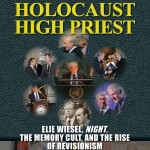
5 Comments
Category Featured | Tags: Tags: Auschwitz, Holocaust High Priest, Israel Shamir, Night, Warren Routledge,
Social Networks: Facebook, Twitter, Google Bookmarks, del.icio.us, StumbleUpon, Digg, Reddit, Posterous.
Tuesday, May 12th, 2015
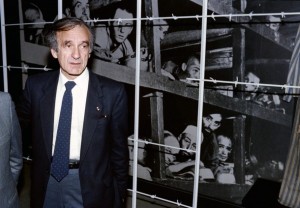
Wiesel stands in front of enlarged image he falsely claims to be himself in a Buchenwald barrack.
To listen to the program, go here
What does it take to light a fire under the guardians of the fixed “Holocaust” narrative and their major champion survivor, the “Holocaust High Priest” Elie Wiesel? If anything can do it, it will be Warren B. Routledge’s just released, almost 500 page book titled, HOLOCAUST HIGH PRIEST: Elie Wiesel, Night, The Memory Cult, and The Rise of Revisionism.
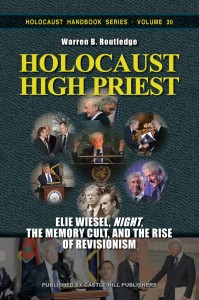
New book by Warren B. Routledge, now available at Amazon for only $26.91
In this book, Routledge shatters the myths surrounding Wiesel that are not allowed to be questioned in the mainstream media. Herein the familiar “Holocaust” narrative is protected as the crown jewel of the New World Order regime that was put in place after 1945 by the victors of World War II.
But among all the revelations that occur throughout the book – and there are many, many – none is more shattering to Elie Wiesel’s image than the author’s belief that he was NOT an eyewitness to the “Holocaust” at all. Wow! How to get that across to the American and world public?
There is an important Appendix at the end of the book which contains an essay by Italian revisionist Carlo Mattogno, translated into English as “Elie Wiesel – The “Symbol of the Shoah.” Following that are the important documents and some photographs that show the reader WHY Elie Wiesel was NOT in the Auschwitz-Monowitz or Buchenwald camps. These documents can also be viewed here on Elie Wiesel Cons The World by clicking on “The Evidence” on the top menu bar.
1 Comment
Category Featured | Tags: Tags: Carlo Mattogno, Holocaust High Priest, The Heretics' Hour, Warren Routledge,
Social Networks: Facebook, Twitter, Google Bookmarks, del.icio.us, StumbleUpon, Digg, Reddit, Posterous.
Saturday, April 25th, 2015
By Carolyn Yeager

We finally have it and you can finally read it. Now only $29.95 at Amazon. enlarge image
There is no one more famously connected to “The Holocaust” than Elie Wiesel. No one whose association with “The Holocaust” does more to keep its believability alive in the minds of millions, even hundreds of millions, of people worldwide. When it comes to “The Holocaust,” he’s the man!
And now comes a lavishly illustrated, unauthorized biography by Warren B. Routledge, who has been studying Wiesel the Myth and Wiesel the Man for many years. This one is not like those “conformist” (as Routledge calls them) bios that we’re so sick of being presented with. This one tells all the truth that he is capable of gathering at this time.
But will you learn anything in this book you don’t already know from reading the website you are now on for free? Yes! Because I have already learned things from just the first four chapters, mainly about the time that’s been most shrouded from view – Wiesel’s ten years in France between 1945 and 1955. In addition, the author Routledge, by using his critical thinking and deep knowledge of French culture, puts the puzzle pieces together in a way that adds greater understanding, even in areas where we don’t have exact knowledge of Wiesel’s actions or motives.
I’m naturally pleased to report that I am mentioned five times in the book – most especially encouraging was the author’s reference to me in his Introduction on page 18:
With regard to Elie Wiesel, Carolyn Yeager’s blog site, “Elie Wiesel Cons the World,” has played an enormous role in recent years by bringing to light a great deal of valuable information about Wiesel. I hope that her work, and that of other revisionists, will continue to flourish.
Even though I have not yet completed the book, I didn’t want to wait until I had carefully read it’s entirety before announcing it here on Elie Wiesel Cons The World. (Don’t want to be falling behind the pack!) I have poked ahead though, to find out whether Routledge might have concluded that Wiesel was not an inmate of either Auschwitz or Buchenwald, as I have gone out on a limb (in most people’s view) and stated here on “Elie Wiesel Cons The World.” While I know already that Routledge has presented a great deal of evidence that suggests Wiesel was not, in the end he is not willing to conclude as much. *see comment #2 below
He does, though, end with a short chapter titled “Conclusion: What Is Needed To Happen Now” in which his eighth and final point is that Elie Wiesel should allow the public to see whether he has a tattoo on one of his arms showing his Auschwitz registration number, OR provide a comprehensible (lol) explanation why not. In this, Warren B. Routledge is clearly in agreement with Carolyn Yeager and EWCTW.
Much to my delight, I will be interviewing Warren Routledge on The Heretics’ Hour on Monday, May 11. I may get into the issue of Wiesel being a complete fraud vs only a partial fraud then. In any case, I’ll be writing more about Wiesel here on this website based on the contents of this book. And may even be fortunate enough to have some follow-up programs with Mr. Routledge. So buy the book and start reading. You won’t be disappointed, of that I’m sure. He’s a very good writer, with a gift for organizing his vast knowledge of all things Wiesel in a way that’s easy to follow, without leaving anything out. ~
9 Comments
Category Featured | Tags: Tags: Carolyn Yeager, Holocaust High Priest, The Heretics' Hour, Warren Routledge,
Social Networks: Facebook, Twitter, Google Bookmarks, del.icio.us, StumbleUpon, Digg, Reddit, Posterous.
Saturday, February 14th, 2015
By Carolyn Yeager
Elie Wiesel is featured in a new full-page ad placed in The New York Times and the Washington Post that is headlined: Iran’s Plan for the Jews, Ancient and Present.
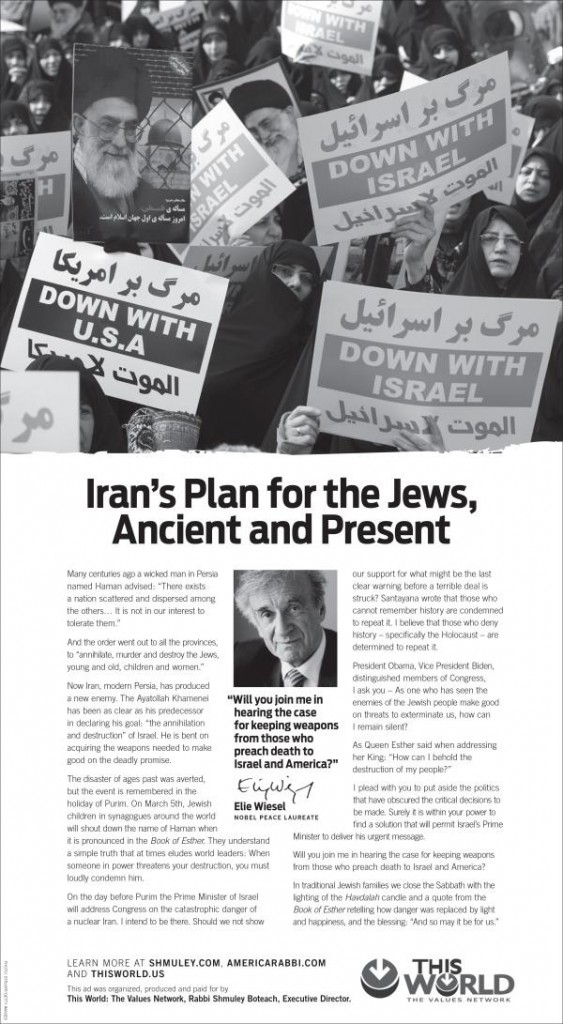
Full page ad featuring Elie Wiesel appeared on Feb. 14, 2015 in the New York Times and the Washington Post.
The ad is was organized, produced and paid for by New Jersey Rabbi Shmuley Boteach‘s “This World: The Values Network.US, an organization of which Boteach is Executive Director. The theme, text, politics and intent of the ad are all so Jewish as to give the message: We don’t need you ordinary non-Jews to attend this speech; we’re only addressing the voting members of Congress and the Jewish community.
The ad uses the totally fictional biblical Book of Esther as the backdrop for the storybook approach to presenting Iran as a wicked nation and the world’s greatest enemy of the Jews. The story goes that a “wicked man” named Haman, a minister of the Persian King (whose biblical name is not mentioned in the ad since it is not historical) was discovered as having a plan to kill all the Jews in the kingdom. But a beautiful Jewish girl in the royal harem got word of it and told the King, who then discovered the plot to be true and hanged the wicked Haman and all of his accomplices. This has become the Feast of Purim celebrated every March 5 when “Jewish children in synagogues around the world will shout down the name of Haman when it is pronounced in the Book of Esther.” After which each good little Jewish child receives a cookie in the shape of Haman, encouraging them to destroy Haman all over again by eating the cookie.
The moral of the story: As the brave Esther saved all her people then, the brave holocaust survivor Elie can do no less today. Netanyahu’s speech on the day before Purim (scheduled for March 3) is presented as “an urgent message” on “the catastrophic danger of a nuclear Iran” that America needs to hear.
Though the ad is directed at President Obama, Vice President Biden and members of Congress, I think it is mainly directed to American Jews and Christian Zionists because Jews are divided over Netanyahu’s visit – divided between Republicans and Democrats, between conservatives and liberals. Abe Foxmann of the Anti-Defamation League (ADL) denounced a petition drive opposing Netanyahu’s speech by the Democrat-leaning pro-Israel J Street as “inflammatory and repugnant.” It’s clear to me that Wiesel and Boteach both work for Israel – Wiesel since 1948. The prose of the ad is written in 4th – 6th grade level, which is the level of newspaper writing in general.
Text of the Ad:
Many centuries ago a wicked man in Persia advised: “There exists a nation scattered and dispersed among the others … it is not in our interest to tolerate them.”
And the order went out to all the provinces “to annihilate, murder and destroy the Jews, young and old, children and women.
Now Iran, modern Persia, has produced a new enemy. The Ayatollah Khamenei has been as clear as his predecessor in declaring his goal: the “annihilation and destruction” of Israel. He is bent on acquiring the weapons needed to make good on the deadly promise.
The disaster of ages past was averted, but the event is remembered in the holiday of Purim. On March 5 Jewish children in synagogues around the world will shout down the name of Haman when it is pronounced in the Book of Esther. They understand a simple truth that at times eludes world leaders. [Oh brother, they just do what they’re told without understanding a thing. -cy] When someone in power threatens your destruction, you must loudly condemn him.
On the day before Purim, the prime minister of Israel will address Congress on the catastrophic danger of a nuclear Iran. I intend to be there. Should we not show our support for what might be the last clear warning before a terrible deal is struck? Santayana wrote that those who cannot remember history are condemned to repeat it. I believe that those who deny history – specifically the Holocaust – are determined to repeat it.
President Obama, Vice-President Biden, distinguished members of Congress, I ask you – as one who has seen the enemies of the Jewish people make good on threats to exterminate us, how can I remain silent? [No you have not seen that. You lie. This whole website devoted to you proves it. But you are unwilling to answer a single question. The first one is: Why won’t you show us your Auschwitz tattoo? It’s not because of “privacy.” It can only be because you don’t have one but claim to have one. Which makes you quite a reckless liar. -cy ]
As Queen Esther said when addressing her King: “How can I behold the destruction of my people?”
I plead with you to put aside the politics that have obscured the critical decisions to be made. Surely it is within your power to find a solution that will permit Israel’s Prime Minister to deliver his urgent message.
Will you join me in hearing the case for keeping weapons from those who preach death to Israel and America?
In traditional Jewish families we close the Sabbath with the lighting of the Havdalah candle and a quote from the Book of Esther retelling how danger was replaced by light and happiness, and the blessing: “And so may it be for us.”
End of text
8 Comments
Category Featured | Tags: Tags: Feast of Purim, Israel, New York Times,
Social Networks: Facebook, Twitter, Google Bookmarks, del.icio.us, StumbleUpon, Digg, Reddit, Posterous.
Sunday, December 28th, 2014
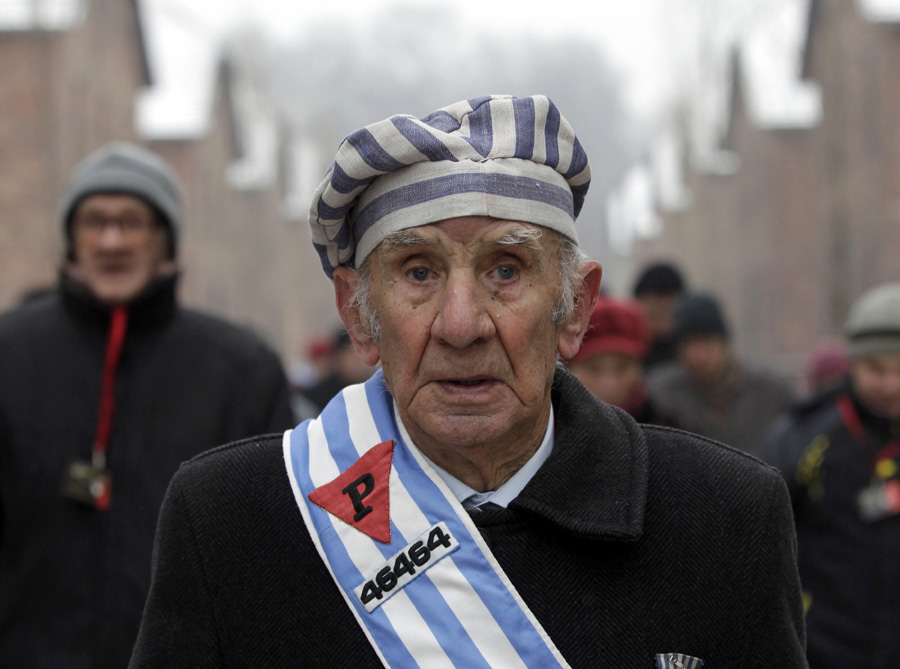
Have we had enough of this theater yet? Do “holocaust” images like this have any effect on our sympathies? This is a well-aged, healthy looking “survivor” at the 69th Anniversary of the Auschwitz liberation on Remembrance Day, Jan. 27, 2014
___________________________________________________________
By Carolyn Yeager
Wiesel: “I thought the memory of the Holocaust would shame those boasting anti-Semitic opinions. I was wrong.” … Jan. 28, 2014
It becomes more clear all the time that the massive goodwill that Jews and “Israel” gained from the propaganda hoax they named “The Holocaust” has been depleted, due in large measure to Israel’s uncivilized aggressive behavior against its neighbors in the Middle East.
But another major reason for the loss of goodwill is Israel’s and world Jewish organizations’ insatiable lust for ever more money and arms from Germany, the U.S. and all of Europe and North America. The Jews have played the phony guilt card for all it’s worth, and for a long time now (70 years!) – and it is finally wearing out. When Jews tell us that grandchildren of “survivors” are carriers of their grandparents’ “trauma,” that becomes the straw that breaks the camel’s back.
Both Elie Wiesel and Caroline Glick have made statements in 2014 referring to the “Holocaust” as a way – a vehicle – to do away with “antisemitism,” i.e. dislike of Jews. They thought the combination of the horrific atrocity stories camp survivors were able to dream up, and the incredible number of 6 million, plus having the governments of America, Britain and the Soviet Union on their side would keep Germans and all European people making amends to them for a good long time – long enough, anyway, for Jewish billionaires to completely consolidate their ownership/control of everything of value in the Western world (just as it’s told in The Protocols of the Learned Elders of Zion).
But as it turns out, European men and women are more resilient than that. And then Jews, in their chutzpah, make plenty of mistakes, too. The end result, as we enter the year 2015, is that Jews, rather than feeling victorious, are crying and gnashing their teeth over “the rise of antisemitism in Europe.”
Is there a conspiracy going on?
Today, I went looking for what I remembered as Elie complaining about antisemitism in the same way that Caroline Glick does. I quickly came upon it, and it was from January 28, 2014, the exact same day that Glick’s blog post appeared! … the one I wrote about here. Coincidence?
They are both saying the same thing, each in their own way, on the day after the “International Holocaust Remembrance Day” on Jan. 27, which was not such a big success. The major news story it conjured up was that the Israeli Knesset sent a large delegation that marched around on Auschwitz memorial grounds with giant blue and white flags, while having their picture taken. Elie Wiesel did not show up, which took away some of the news-worthy luster of the 2014 event.
It’s interesting that Benjy Netanyahu was saying pretty much the same as Glick and Wiesel just recently:
“We saw today examples […] of European prejudice. In Geneva, they are calling for an investigation against Israel for war crimes, while in Luxembourg the European court removed Hamas from the terrorist list. It looks like there are too many people in Europe, on the [same] ground where six million Jews were slaughtered, who haven’t learned a thing. The friendship we see from the United States stands in complete contrast to what we are seeing regretfully in Europe.”
Recall that Caroline Glick once worked as an assistant to Netanyahu. She and Elie Wiesel are both long-time Israeli assets, so do they coordinate their message?
What exactly did Wiesel say in this interview of eleven months ago?
“The Holocaust is a unique event, but it has a universal significance which must be memorized incessantly.”
“Unfortunately, anti-Semitism still exists. It has been alive for more than 2,000 years, and will likely continue living. I thought that the memory of the Holocaust would shame those boasting anti-Semitic opinions. I was wrong. It still exists in different countries, and it seems people are no longer ashamed to be anti-Semitic.”
“The modern anti-Semite is, first and foremost, anti-Israel. It’s very difficult to separate between the two.” (Anti-Israelism and antisemitism)
“There are anti-Semites who are only anti-Israel. Once I thought that anti-Semitism had ended; today it is clear to me that it will probably never end. It might weaken sometimes, but it will continue existing, because in different countries there is no shame in being an anti-Semite. We must remember that anti-Semitism led to Auschwitz. Without anti-Semitism there would have been no Auschwitz.”
“It’s clear to me that one can’t be Jewish without Israel. Religious or non-religious, Zionist or non-Zionist, Ashkenazi or Sephardic — all these will not exist without Israel. The [Israeli] State’s existence is the oxygen of the image and ideas of the new anti-Semitism.“
“Recent attacks on Jews in the United States are expressions of anti-Semitism, yet we can’t talk about an anti-Semitic movement but about groups of anti-Semites which operate in different places, and we don’t know how many members they have. This reality must also concern us, because it could expand.”
The difference between Wiesel and Glick is that he did not say the Jan. 27th International Holocaust Remembrance Day made antisemitism worse, not better, but he DID rather dismiss it by saying that in the United States it is only marked with an event held at the UN building.
He agrees with Glick that the real American commemoration is on Yom haShoah, the same day as for the State of Israel. According to Yoel Rappel, the Israeli whom Wiesel appointed to be the director of his archive at Boston University, it was Wiesel who proposed this day to the American Congress when he was chairman of the President’s Commission on the Holocaust under President Carter. It has become a “fixed tradition” in the U.S., said Rappel. ~
4 Comments
Category Featured | Tags: Tags: anti-Semitism, Caroline Glick, Holocaust fraud, Holocaust Remembrance Day, Israel,
Social Networks: Facebook, Twitter, Google Bookmarks, del.icio.us, StumbleUpon, Digg, Reddit, Posterous.
Wednesday, May 14th, 2014
By Carolyn Yeager
Childhood home of biggest con-man in holocaust history becomes “education center” for hoax-a-cost lies
Museum to open May 18 in the Romanian town of Sighet

Above: Wiesel "childhood home" in Sighet, Romania in 2007 after remodeling. Note identifying plaque attached at right corner.
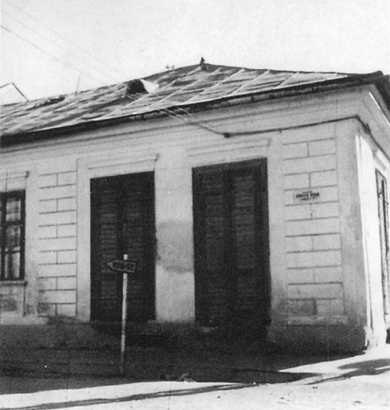
Same building as it appeared in 1965 before Wiesel's great fame. "Night" was published in 1960 but didn't start to sell until the 1990's when the US media establishment began to promote it and schools bought it.
The “learning center” will be dedicated to the alleged 13,000 local holocaust victims who will have been receiving monthly checks from the Federal Republic of Germany for the past 65 years (either they or their relatives).
This rip-off “education center” is sponsored by the Conference on Jewish Material Claims Against Germany, the Romanian Jewish Federation* and Limmud FSU, plus the Government of Romania and the City of Sighet (it’s good for tourism). Interesting that the Conference on JMClaims can spend the money it gets from Germany on projects like this, but it can … on the basis that it somehow helps survivors. Indeed, it helps them to keep up their fiction. *I can’t find an organization of this name.
Everything is being done to establish physical memorials to Elie Wiesel in as many locations around the world as can be conjured up, in consideration of his advanced age (85) and inevitablility that his death could come at any time. As usual, though, the Jewish interests behind the “Elie Wiesel Legend” seek to use as much Goyim money as possible to cover the costs. Wiesel himself has been doing that exact thing during his entire career as a professional victim and survivor.
8 Comments
Category Featured | Tags: Tags: Elie Wiesel, Jewish Material Claims Against Germany, Sighet,
Social Networks: Facebook, Twitter, Google Bookmarks, del.icio.us, StumbleUpon, Digg, Reddit, Posterous.
Sunday, February 2nd, 2014
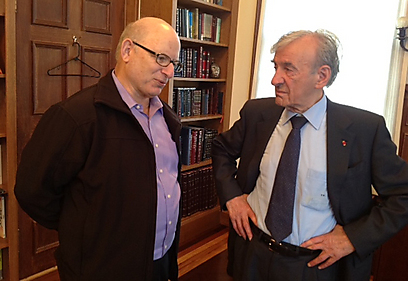
Elie Wiesel, right, in his office at Boston University with his Israeli editor, Yoel Rappel, whose interview with the famous survivor was published on January 28th in Israel’s Y-Net News.
By Carolyn Yeager
“Personal reasons” has been given for Elie Wiesel’s failure to attend this year’s annual International Day of Commemoration in Memory of Victims of the Holocaust at Auschwitz-Birkenau January 27th. This United Nations-declared commemoration day (since 2006) is being incorrectly called “Holocaust Memorial Day” or “Holocaust Remembrance Day” by the media and others who don’t feel like repeating the long, actual title.
The latter can become a problem because, as Wiesel’s interviewer pointed out in what follows : “The American nation officially commemorates the memory of the victims of the Holocaust on the same day as the State of Israel” — that is, on Yom Hashoah according to the Hebrew calendar, which falls in the Spring (April or May). This event is called “Days of Remembrance” and lasts for 7 days, beginning on Saturday evening Shabbat and ending at Shabbat one week later. In this, like in so much else, the U.S. is in lock-step with Israel (with Israel leading, the United States Congress following).
However, both the U.S. and Israel also support and join in with the newer January 27th United Nations-proclaimed commemoration, since it was conceived and pushed through the UN by the State of Israel. See here at bottom of page. That gives the world two major “Holocaust remembrance” events, all the better to “engrave” the holocaust into the minds of all humanity, but especially Western man.
The Interviewer
 Yoel Rappel grew up in Israel and lived most of his life there. We’re not told if he was born there, but it seems so. He worked 40 years as a journalist and senior program editor at the Israel Broadcasting Authority, Israel’s main radio channel. Before coming to Boston University as Visiting Scholar at the Elie Wiesel Center for Jewish Studies, he also taught at Bet Berl College, the Avshalom Institute for Israel Studies, and served as content manager at the Center for Jewish Identity in Bar Ilan University … all in Israel.
Yoel Rappel grew up in Israel and lived most of his life there. We’re not told if he was born there, but it seems so. He worked 40 years as a journalist and senior program editor at the Israel Broadcasting Authority, Israel’s main radio channel. Before coming to Boston University as Visiting Scholar at the Elie Wiesel Center for Jewish Studies, he also taught at Bet Berl College, the Avshalom Institute for Israel Studies, and served as content manager at the Center for Jewish Identity in Bar Ilan University … all in Israel.
He serves as project manager for the Elie Wiesel Archive. He is the editor of the Hebrew editions of Prof. Wiesel’s books “The Biblical Soul,” “The Hasidic Soul” and “The Talmudic Soul,” which were published in Hebrew by the Yedioth Books publishing house. [Getting everything ready for Elie Wiesel’s coming sainthood -cy]
The Interview
[Rappel points out that it was Wiesel who coined the expression, “Not all victims were Jews, but all Jews were victims.” ]
Wiesel: “The Holocaust is a unique event, but it has a universal significance which must be memorized incessantly.”
[The reason for this, Rappel tells us, is so it will be engraved in people’s minds, so that the events of 1939-1945 will not repeat themselves and the world will not be indifferent and silent*, as it was then.] *A reference to the Yiddish book, “And the World Remained Silent” claimed to have been written by Wiesel.
Wiesel: “Unfortunately, anti-Semitism still exists. It has been alive for more than 2,000 years, and will likely continue living. I thought that the memory of the Holocaust would shame those boasting anti-Semitic opinions. I was wrong. It still exists in different countries, and it seems people are no longer ashamed to be anti-Semitic.”
[Rappel says “the murky wave of anti-Semitism sweeping over the Western world, as well as Eastern Europe (with the recent incidents in Hungary and Ukraine), is fresh.]
Wiesel: “The modern anti-Semite is, first and foremost, anti-Israel. It’s very difficult to separate between the two. There are anti-Semites who are only anti-Israel. Once I thought that anti-Semitism had ended; today it is clear to me that it will probably never end. It might weaken sometimes, but it will continue existing, because in different countries there is no shame in being an anti-Semite. We must remember that anti-Semitism led to Auschwitz. Without anti-Semitism there would have been no Auschwitz.”
[Rappel says that Wiesel is one of the State of Israel’s greatest advocates, and that Wiesel argues that the fundamental problem {today?} is the attitude towards Israel and not anti-Semitism.]
Wiesel: “It’s clear to me that one can’t be Jewish without Israel*. Religious or non-religious, Zionist or non-Zionist, Ashkenazi or Sephardic – all these will not exist without Israel. The State’s existence is the oxygen of the image and ideas of the new anti-Semitism.” *Dangerous, fanatical talk. It follows that if Israel goes, so also do Jews. With that thinking, anything is allowed to Jews to prevent it … is what Wiesel is getting at. The failure of Israel would be another form of “extermination of the Jews,” another “holocaust.” -cy
[Wiesel is asked whether the public dispute over circumcision and ritual animal slaughter also stem from anti-Semitism.]
Wiesel: “In my opinion, it stems first of all from ignorance and disregard of the Jewish faith. Those who raise such ideas and others will soon come up with the idea to cancel Shabbat, so that Jews will rest on Sunday. It’s more of a case of ignorance, and it leads to harassment against the foundations of Judaism.”
[Rappel wants to know if the different phenomena experienced recently by the Jewish community in the United States can be defined as anti-Semitism.]
Wiesel: “There are expressions of anti-Semitism, yet we can’t talk about an anti-Semitic movement but about groups of anti-Semites which operate in different places, and we don’t know how many members they have. This reality must also concern us, because it could expand.”

What Wiesel Missed – Members of Israeli parliament, the Knesset, ceremoniously and ostentatiously mark the 69th anniversary of the liberation of Auschwitz in Oswiecim, Poland on Jan. 27, 2014. The delegation spokesman made it a point to say that the difference between then and now is that they now have a state and a military force of their own with which to protect themselves.
2 Comments
Category Featured | Tags: Tags: anti-Semite, anti-Semitism, Auschwitz-Birkenau, Boston University, Holocaust remembrance, Israel, Joel Rappel, shabbat, Yom Hashoah,
Social Networks: Facebook, Twitter, Google Bookmarks, del.icio.us, StumbleUpon, Digg, Reddit, Posterous.
Friday, October 18th, 2013
 By Carolyn Yeager
By Carolyn Yeager
In January 2011, I featured a Letter of the Week from Hailey S. In November the same year I featured two more, from Shelby and Sarah. Now I have received three more complaints about this site from (another?) Hailey, a Katie and a Lauren — right in a row. Thank you ladies!
But it’s an odd thing — the latest three were all sent from the same computer. And with an email address that ends in the same edu., which I won’t reveal. I’m not even sure it’s legitimate … that is, a real school. Could these young ladies be friends conspiring together in writing their comments? Could they even be the same person using different names and slightly different email addresses?
The content and point of view is similar, but written in different ways. You will find that “belief” and “believing” are the major basis for, well, believing the “holocaust.” These comments are also similar to the earlier ones I published from Hailey S, Shelby and Sarah, although better written and thought-out. So I could reply to them all together, but since they are written to three different blog articles they appear on different pages. This is why I decided to reply to them here, under the title of “More Letters of the Week.”
First, from Hailey, who sent her comment to “Elie’s Adventures in Buchenland” on Oct. 14:
I find the trivialization of the Holocaust extremely disgusting. It maybe that some don’t believe that Elie Wiesel was an actual part of the Holocaust, but that does not mean anyone has the right to make fun of or make light of a horrific historical event. An event that almost entirely wiped out an entire group of people. There is an amount of dignity that must be maintained when dealing with this horrific time in history.
I already replied to Hailey on that page, so I’ll just say here that she’s free to express her feelings but I hope she understands that that is all she’s doing. Hailey has been indoctrinated into believing that “Holocaust survivors” are telling the truth about their “horrific” suffering and that “an entire group of people [by which she means Jewish people] were almost entirely wiped out.” Honest research has shown otherwise, but Hailey prefers to ignore this research.
The second comment is from Katie, who sent her comment to “Elie Wiesel Was Not in Buchenwald Made Simple“ on Oct. 16:
I think that there could be a logical explanation to explain the holes in Elie’s story. I cannot bring myself to believe that someone would fictionalize a story on the holocaust and its terrible events. When someone under goes a traumatic event they will most likely not be able to remember every detail perfectly therefore he may have been confused on the dates and times. Elie has also grown older in age which also may make it difficult for him to remember. His book Night, is very detailed and descriptive which makes it difficult to believe that he could make those events up. This blog also states that Elie has not been asked to explain his discrepancies in his “tale”. Could it possibly be because there is no solid proof to question his story? And if he wasn’t actually a survivor than his book is still an incredible account of a Jewish person in the Holocaust and is still educational and provides people with an insight to the terrible things that happened.
Poor logic here. Katie says, “I cannot bring myself to believe …” — she is also putting her belief first. How many times can we repeat that reality is not about belief. It’s about facts and evidence. Belief belongs in religion — in this case the religion they have all been brought up in: Holocaustism.
Katie brings up belief a second time, saying in essence that after reading Night, she finds it “difficult to believe that he could make those events up.” But Wiesel is primarily a fiction writer and has made up lots of stories about Jews; in fact Night was for a long time listed and sold as fiction! Good fiction makes us believe it’s real even when we know better.
As to the “logical explanation” Katie thinks could be found, she doesn’t come up with one. Illogically, she says that Elie was traumatized and thus not able to remember well. But Elie has always said he waited for 10 years to write his book so that he would have a clearer mind about it. Her other “logical explanation” is: Elie is now elderly and has a poor memory, thus he gets mixed up on dates and times. But Elie wrote Night in 1955, and it is in this book that the problems exist — the book itself is inaccurate and inconsistent. Since that time he has continued to say different things — inconsistent things.
Katie’s final remark falls back on what the bulk of “Holocaust” defenders come up with: Even if he wasn’t a survivor, it’s still an “incredible [fictional] account” providing an insight into the terrible things that happened. How does he know what happened if he wasn’t there? He made it all up, taking the framework for what others had already said about it. Stop defending this multi-millionaire shyster, Katie.
Third, is Lauren, who sent her comment to “Ken Waltzer inadvertently supplies proof that Elie Wiesel was not at Buchenwald“ on Oct. 16:
I find this constant speculation about the validity of the Holocaust and its survivors extremely disturbing. The Holocaust was not a glamorous event, therefore, I find it hard to believe that someone would make up a story about being a victim of such tragedy. While I realize that many people would consider my opinion to be a ‘too optimistic’ view of human nature and morality, there is a lot of information to support the fact that Elie Wiesel was at the camp without the information that Mr. Waltzer is supposedly with-holding.
Once more, we find the belief mode: “I find it hard to believe that someone would make up a story…” Why? Hundreds of fake survivors have done so. What does it take for you to give up this childish belief in a religion of sadistically persecuted Jews?
You say it is not a glamorous event … but for ordinary “non-glamorous” Jews it is the ultimate stardom, and a very lucrative source of money too. Not only from the books they write, but also from the talks they give on the “speakers circuit” — and how they love all that respectful attention. They also love fooling so many Gentiles.
You say “there is a lot of information to support the fact that Elie Wiesel was at the camp …” No, there isn’t! This entire web site is devoted to showing that the alleged “information” is false or simply does not exist. Yet you cling to your belief in the non-existent. That is religion, not history, Lauren.
You are also mis-stating the case when you say Mr. Waltzer is withholding information. He is withholding nothing, for he doesn’t have the information he claims. Your Mr. Waltzer is another fraud who’s been caught in his frivolous promises. I know it’s tough for you to accept. But logic should tell you that if Waltzer had the information he would have put it out there already. He is embarrassing himself as a university professor by remaining silent and not publishing it. In failing to do so, he is proving my point … not yours.
Well, young ladies, thanks for your written words. They are a treasure. You are of course welcome to write again, but I caution you that I expect you to address my replies to you in some way. If you just write more of the same I probably won’t publish it. I don’t want to bore the readers. So step up to the plate!
18 Comments
Category Featured | Tags: Tags: belief vs evidence, Buchenwald, Elie Wiesel, history vs religion, Holocaustism, Kenneth Waltzer, Letter of the Week,
Social Networks: Facebook, Twitter, Google Bookmarks, del.icio.us, StumbleUpon, Digg, Reddit, Posterous.
Sunday, September 8th, 2013
By Carolyn Yeager

Above: Ken Waltzer’s now notorious signature photo connecting him to his claim, for years, that Elie Wiesel was in this photograph of youths from the Buchenwald children’s barracks being marched out of the camp after so-called liberation.
We have further proof that Elie Wiesel was not at Buchenwald because Prof. Ken Waltzer is still unwilling to publish his book about the “rescue of children from Buchenwald,” a book which has always included the “Nobel Laureate Elie Wiesel”among the children.
Since Waltzer is the only holocaust “historian” I know who is still on record as saying he can prove that Elie Wiesel was a prisoner at the Buchenwald concentration camp—and that his father Shlomo died there—I think that makes Waltzer a fitting subject for this website. And the 84-year old Wiesel himself is not doing anything that I can find news of these days, so I’m a little hard up for inspiration.
Thus I ask: What is Waltzer up to? Well, he has been heading a group of Michigan Jews in creating a traveling exhibition that is meant to remind Jews, and convince if necessary, of all the poisecution they experienced during the WWII years and to celebrate how extraordinarily well things have been going for Jews since (while, of course, still having to be on guard against new poisecution).
Thus, the exhibition is titled Uneasy Years: Michigan Jewry During Depression and War. Michigan Jewry! How many Jews are in Michigan? According to a Jewish website, in 2012 there were 82,270, which is 0.8% (8/10 of 1%) of the total Michigan population. But that is enough for Ken Waltzer and other Jews to build an entire traveling exhibition for.
Or could the reason really be that Waltzer, as a professor at Michigan State University, must always show that he is active and contributing scholastically in his area of expertise. Since his book on the “rescue of children at Buchenwald” continues to be in a state of “research”—after all these years—he must find other projects to work on. 1 Last year he was consultant on a Jewish film project about holocaust survivors. This year he’s got the traveling exhibition.
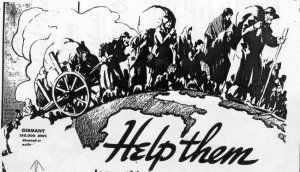 What is learned from the exhibition
What is learned from the exhibition
The 21st Century Jews of Michigan are told that in past times they had to join together to help needy fellow Jews. The message is conveyed that they still need to do so because Jews are always in need, as “anti-Semitism” is always a threat—somewhere. Hasn’t it always been so? Elie Wiesel would approve of this message! [Right: Theme image for the Allied Jewish Campaign, 1938]
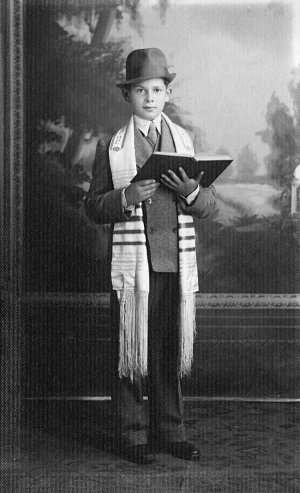 The main thing I notice about this exhibit is that it is totally, 100% about Jews and specifically Jewish concerns. The few non-Jews mentioned are enemies of the Jews. While it starts out saying that by the 1930’s Jews were increasingly comfortable with American ways, it shows nothing about Jews integrating socially with American gentiles and Christians, but only sticking closely with their own kind, their own organizations, their synagogues and businesses. Jews want to be accepted by the majority Gentile culture as “just like them,” but they do not want to participate in the majority Gentile culture, except politically and financially. [Left: Bar Mitzveh Day for Harry Klein]
The main thing I notice about this exhibit is that it is totally, 100% about Jews and specifically Jewish concerns. The few non-Jews mentioned are enemies of the Jews. While it starts out saying that by the 1930’s Jews were increasingly comfortable with American ways, it shows nothing about Jews integrating socially with American gentiles and Christians, but only sticking closely with their own kind, their own organizations, their synagogues and businesses. Jews want to be accepted by the majority Gentile culture as “just like them,” but they do not want to participate in the majority Gentile culture, except politically and financially. [Left: Bar Mitzveh Day for Harry Klein]
It tells us that Michigan Jews were terribly affected by the war in Europe—the spread of Nazism in Europe brought rising “anti-Semitism” in the U.S, and Michigan was not spared! Evil people like Catholic priest Father Charles Coughlin were openly “anti-Semitic” and 30 million non-Jewish Americans listened to his weekly radio broadcasts. [Shown at right speaking over WJR radio in the 1930s] The exhibit particularly excoriates Father Coughlin simply because he warned about excessive power of the Jews. The exhibit shows that Life and Time magazines, and the powerful Detroit Free Press were all on the side of the Jews against Father Coughlin … so where was the problem? Are we dealing with a real threat or with some kind of Jewish agenda here?
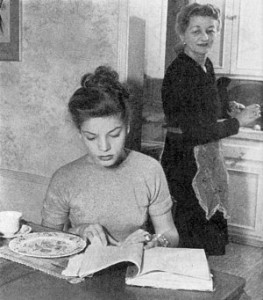
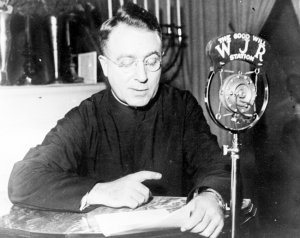
At the same time, Jews like Lauren Bacall [at left as a young woman at home – look at the nose on Mom! Was Lauren given a nose job?] and baseball player Hank Greenberg were given great, positive media attention.
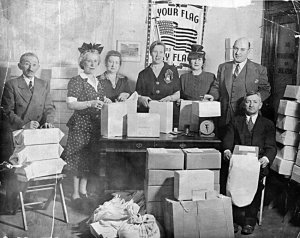 The exhibit tells how the Jews of Michigan supported the war. America’s participation was a wonderful thing. Helping the European Jews was what we should all be doing. Jews like young Harriet Fields collected 381,000 pounds of household waste fat! The Federation of Polish Jews in Detroit [shown right, publicizing their war service] sent packages to the men and women of the Armed Services. The Jewish-owned Paramount Coffee Company of Lansing sent out New Year’s Greeting flyers about the importance of helping one another (without mentioning the war at all, though). The Temple Beth El Bulletin encouraged people to buy war bonds!
The exhibit tells how the Jews of Michigan supported the war. America’s participation was a wonderful thing. Helping the European Jews was what we should all be doing. Jews like young Harriet Fields collected 381,000 pounds of household waste fat! The Federation of Polish Jews in Detroit [shown right, publicizing their war service] sent packages to the men and women of the Armed Services. The Jewish-owned Paramount Coffee Company of Lansing sent out New Year’s Greeting flyers about the importance of helping one another (without mentioning the war at all, though). The Temple Beth El Bulletin encouraged people to buy war bonds!
Jewish organizations made sure they offered social and spiritual support for specifically Jewish soldiers. Beginning in 1942, Jews began protesting a “Nazi Holocaust” of European Jews in Detroit newspapers and in public meetings. The exhibit shows pictures of two whole Michigan Jews who had fallen … they are portrayed as heroes. And it doesn’t leave out that America did not want to take in all of Europe’s Jewish refugees who wanted to come here. It points out everything that the Jews did to help other Jews, and how they got non-Jews to help Jews too.
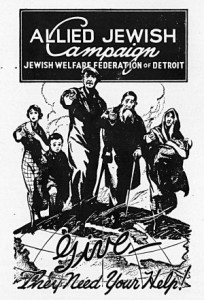 The Allied Jewish Campaign raised money to help Jews. Wow, what sacrifice! “Between 1932 and 1940, its theme shifted from taking care of the needy Jews in the United States to supporting rescue and survival of Jews abroad.” It’s fundraising goal rose from $165,000 to $925,000. Guess who they got most of the money from?
The Allied Jewish Campaign raised money to help Jews. Wow, what sacrifice! “Between 1932 and 1940, its theme shifted from taking care of the needy Jews in the United States to supporting rescue and survival of Jews abroad.” It’s fundraising goal rose from $165,000 to $925,000. Guess who they got most of the money from?
And, of course, “Michigan Jews, especially in Detroit, were active on behalf of building a Jewish homeland in Palestine.” Finally, the stories of four Jewish children who came to the U.S as refugees and are such treasures. Then, MSU’s Jeanette Abeles , Ken Waltzer and Michael Seadle tell stories, with pictures, of their Jewish family history, though none were connected with Michigan. Have we heard enough about Jews yet?
From whence the money comes
This traveling exhibition was made possible with financial support from Congregation Shaarey Zedek of East Lansing, Michigan State University Jewish Studies Program (that’s Waltzer’s domain), Michigan State University Museum, the Michigan Humanities Council, the Ben Teitle Foundation, the Michigan Council for Arts and Cultural Affairs and private donors.
For a fee of $800, plus shipping, the exhibition has been displayed at the following sites so far (according to the website): Northern Michigan University, Marquette, MI; Macomb Community College, Clinton Twp, MI; and Kalamazoo Valley Museum, Kalamazoo, MI.
This “anti-anti-Semitism” project extolling the virtues of Jews is what Ken Waltzer has kept himself busy with in 2013, instead of finishing his book on the children of Buchenwald. What will he come up with next? It’s been clear for some time that the main guiding force for Waltzer is the promotion of Jewry, in whatever way best achieves that goal. Holocaustianity is certainly one way. Heading a Jewish Studies program at a university is another. Working in conjunction with the U.S. Holocaust Memorial Museum is another. And certainly, protecting and promoting the image of Elie Wiesel is also one.
It’s possible, however, that he’s run into a brick wall on Elie Wiesel.
Endnotes:
1. Waltzer admittedly relies on survivor testimony – the least dependable form of “evidence.” In this 2011-2012 Q-A session linked to above, he says:
… my own book, Telling the Story: The Rescue of Children at Buchenwald, will be finished in about a year and will tell the story in much greater detail and more attention to complexity, drawing on information obtained from nearly 200 of those who were helped to survive at the Nazi camp. It will say more about who these boys were, what their experiences were both before Buchenwald and then inside Buchenwald, and where they went and what they did with their memory of experience after liberation. A second book, to be prepared thereafter, will be called Children’s Stories, and will pull together many distinctive stories I’ve been told or have encountered while working on the collective story.
Note that Waltzer is “telling a story” that has been told to him by old men about what happened to them as children. Realize what “story” means to Jews – one is freed from all necessity of accurate fact.
8 Comments
Category Featured | Tags: Tags: Allied Jewish Campaign, anti-Semitism, Charles Coughlin, Hank Greenberg, Jeanette Abeles, Jewish homeland in Palestine, Ken Waltzer, Lauren Bacall, Michael Seadle, Michigan State University,
Social Networks: Facebook, Twitter, Google Bookmarks, del.icio.us, StumbleUpon, Digg, Reddit, Posterous.
Sunday, July 28th, 2013
By Carolyn Yeager
Copyright 2013 Carolyn Yeager
(last edited on 7-30-13)

“How puzzling all these changes are! I’m never sure what I’m going to be, from one minute to another.”
― Lewis Carroll, Alice’s Adventures in Wonderland
Introduction: In Elie Wiesel’s book Night, we find the scenario and characters changing often, and in many cases, with little rhyme or reason that is apparent to the reader. One easily concludes that, like Alice’s Adventures in Wonderland, it is a work of absurdity.
In Lewis Carroll’s classic, nothing makes sense because nothing has to make sense – the intention was to be a “childish” type of foolishness or make-believe from the start. It is an example of literary nonsense (1) genre. Interestingly, we find similar examples of nonsense and absurdity in many of the stories and writings of self-proclaimed “holocaust survivors” – and we put Elie Wiesel into this category. This is why Alice’s Adventures in Wonderland is such a good fit for a parody of Elie Wiesel’s Night.
Cast of Characters:
Elie = Elie Wiesel
White Rabbit = Ken Waltzer
Father = no such person has been found
The King and Queen of Hearts = SS-Totenkopfverbände (SS-TV)
The Duchess = Hilda Wiesel
The Cheshire Cat = Carolyn Yeager
The March Hare = Antonin Kalina, Czech communist block leader
The (Mad) Hatter = Gustav Schiller, Polish Jew block leader
Elie is quite bored one warm afternoon at the Jewish orphan’s mansion in France where he lives. This is not unusual for Elie, who has absolutely nothing to do all day but play chess or study the Talmud or other holy texts of which he is known to be almost fanatically fond. Today, though, no one was around the chess table that had been set up outdoors under a large tree, and Elie becomes a bit dreamy, maybe even sleepy. He is suddenly brought wide awake again when he sees a White Rabbit run by, looking at its pocket watch and muttering “Oh dear, oh dear, I’m going to be late!”
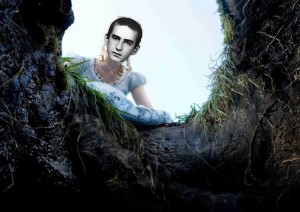 Elie, having never heard a rabbit speak to itself before, let alone have a pocket watch, impulsively runs after the comical creature right into a large rabbit hole. He feels himself slowly falling a long distance before he comes to solid ground. When he does, an unrecognizable landscape of trees, shrubs and creatures such as he has never seen before greets his blinking eyes, and a feeling of being an innocent young girl in an enchanted garden comes over him.
Elie, having never heard a rabbit speak to itself before, let alone have a pocket watch, impulsively runs after the comical creature right into a large rabbit hole. He feels himself slowly falling a long distance before he comes to solid ground. When he does, an unrecognizable landscape of trees, shrubs and creatures such as he has never seen before greets his blinking eyes, and a feeling of being an innocent young girl in an enchanted garden comes over him.
Before he can wonder too much at this, he catches sight of the White Rabbit again and follows him until he is stopped by a barbed wire fence. Standing before it, just the thought of how he might squeeze through the wires to the other side as the rabbit did causes him to shrink to just the right size to step through. As he does—suddenly—he is in a closed railway car with many other people, Jews like himself.
Elie is so unhappy at this turn of events he begins to cry. He cries so much and so hard his tears flood the rail car, making all the others inside very angry, including his own late father whom now, however, seems to be very much alive. As the water made up of Elie’s tears rises closer to the top of the boxcar, the door opens and the inhabitants swim out with the rushing flood.
Appearing for all the world like a catch of wet fish flapping on the platform, the unfortunates find themselves being questioned by a large Caterpillar-looking officer seated on a high stool smoking a hookah. But not one of them is able to answer the officer’s questions as to the particulars of who they are.
“I’m afraid I can’t explain myself, sir. Because I am not myself, you see?”
― Lewis Carroll, Alice in Wonderland
The Camp Buchenland
The hookah-smoking officer tires of their inability to name themselves and, pointing in a certain direction, tells them to march that way to a camp where they will get dry clothes. Once there, the group lines up in an open assembly area and is told they are in Buchenland, the kingdom of the Queen of Hearts who, in spite of her kindly-sounding name, gives orders that must be obeyed. Ordered to now go to the showers where they would also receive the promised new clothing, Elie and Father already fail to obey.
The entrance to the showers is crowded with pushing, shoving people. Father sits down on the ground outside, “I can’t go on anymore; I’ll wait here until we can go into the showers.” As the two lose themselves in an argument over the subject of impending death, the electric lights go out and a loudspeaker commands that all must now be in their assigned barracks.
In haste, Elie follows a crowd into a nearby barracks, where, still unshowered, he falls to the floor and sinks into a dreamless sleep. It is only in the morning that he realizes he is alone; he must have lost his father in the rush to the barracks, and then forgotten about him! Going in search, he wanders about the camp for hours, unmolested by any officers or guards of the Kingdom. Happening upon a place where coffee is being distributed, he gets in line for a cup and magically hears the voice of his father calling to him.
From then on, for the next 7 days (as well as days can be counted in Buchenland), Elie keeps coming back to his father, looking after him in a rather haphazard fashion. Father is not well, not well at all, and Elie, “for a ration of bread,” is able to secure a cot next to his father in the barracks.(2) But a few days later, Elie is sleeping on the upper bunk, above his father, because of his (Elie’s) bandaged foot.(3)
The time comes that Father passes his last breath in his bunk during the middle of the night. According to Elie’s reckoning, it is February 8th-9th, 1945. But elsewhere, Elie states his father died on the night of January 28-29, and again on the 18-19 of Shevat, 5705, which corresponds to February 1st.(4) Elie is both secretly relieved and personally devastated over the loss of Father and blames it on the cruelty of the officials of the Kingdom of Buchenland, calling it murder.
The Queen of Hearts learns about young Elie’s defamations against her health care system, and at the same time the multiple death dates he asserts for his father, and proclaims with great indignation that this cannot be allowed in her Kingdom. The King agrees and they summon the culprit to their presence. After listening to Elie’s disconnected narrative of how he came to be in Buchenland and how he lost his father, she loses patience with the constantly changing versions of his story and shouts “Off with his head!”
Elie is put on trial
Elie is taken to court to be tried for the offense of butchering his father’s date of death. The King and Queen are seated on the high bench. Elie is formally charged with reckless endangerment of the facts of his father’s death. To everyone’s surprise, The Duchess arrives at the court, accompanied by her cat, and asks to testify for the accused. She is granted her request and takes the stand.
You know, [father and son] did a long march from Auschwitz, then they put them on the train to go to Buchen[land]; [Father] died gasping for air. When he stepped off the train, he died gasping for air; at Buchen[land]. But [Elie] knew the date.(5)
The Queen frowns; she is impatient of such testimony that adds even another version of the death in question—what can The Duchess be up to anyway? Then the Duchess’ Cheshire Cat begins to speak, saying the entire court is out of order because the father of the defendant is not the same as the 44-year old man who actually died and is listed in the Buchenland death records; therefore the date that Elie’s father died is irrelevant. Angered to hear it said that her court is out of order, the Queen shouts “Off with his head!” pointing to the Cheshire Cat. As the Queen’s guards move toward the cat to seize him, he cleverly disappears his body, leaving only his head for the spectators to see. How then can his head be chopped off?
Realizing she has been outwitted by a cat, the Queen then turns to Elie and declares him “Guilty! Off with his head!” As Elie is being escorted to the place of execution, he and his guards meet up with the Cheshire Cat again, now sitting in a tree. The Cat advises them to go to the March Hare’s house instead, warning, however, that the Hare is quite mad. “But then, everyone here is mad,” the Cheshire Cat adds with a grin, before he disappears altogether, leaving only his grin still floating in the air.
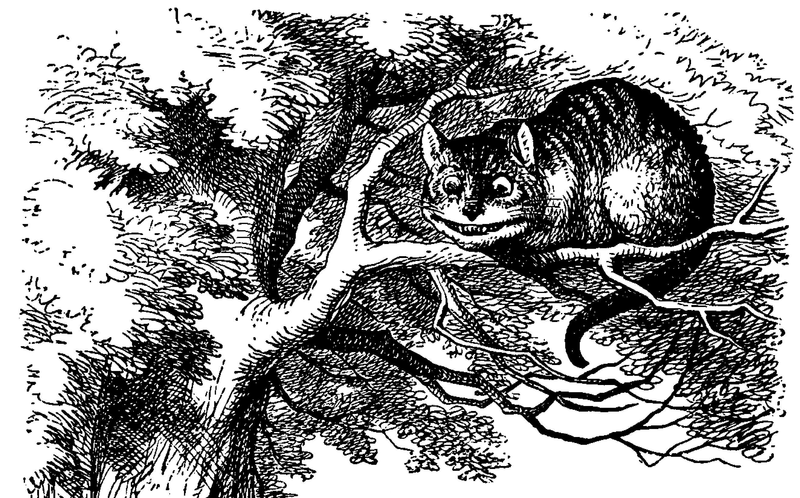
“Who in the world am I? Ah, that’s the great puzzle.”
― Lewis Carroll, Alice in Wonderland
The Hatter’s Tea Party
The White Rabbit is again spotted running ahead as if leading them to the house of the March Hare, which turns out to be another barracks, this one called the “Children’s Block.” Inside, the Hare and his companion The Hatter (also mad—in fact “mad as a hatter”) engage the children in a continual tea party intended to take their minds off the dreariness of their surroundings.
Elie, feeling grateful (for a change) to still have his head on his shoulders, takes a place at the tea table. He is hoping for something good to eat, as he has now lost interest in everything around him except food. But while the Hare and the Hatter provide nothing in the way of food themselves, Elie still finds the tea party routine—one of constantly changing seats, asking unanswerable riddles and reciting nonsensical poetry— much to his liking.
The Hatter has red hair, carries a big stick and likes to boss the children around in his Polish Yiddish. The March Hare is actually of Czech origin and is known to be at his most mad during the month of March, which it happens to be at this very time. Thus do the days pass in the children’s block.
The overthrow of the Queen
However, when the month of April rolls round, the Queen of Hearts discovers that Elie has been hidden in the house of the March Hare and commands the whole place be evacuated. Every day, for several days, Elie is marched to the camp gate with the other children—rumor has it either to be taken away and disposed of or to be given bread and marmalade outside the gate—but every day he is stopped right before the gate and returned to the March Hare’s house. No marmalade and no explanation given.
On the 11th, the enemies of the Queen from outside Buchenland arrive in such great numbers that all the King and Queen’s guards are forced to flee, leaving Buchenland in the hands of the Mad Hatters and the March Hares. In their celebratory mood, on the third day of what they term the “liberation,” they throw open the Queen’s royal pantries and a real party begins. Elie greedily gorges himself on whatever comes first to hand, causing a poisonous shock to his system. He falls unconscious, is taken to a hospital and doesn’t recover for two weeks.
Buchenland doesn’t even notice Elie’s absence. The new owners are busy taking photographs(6), writing publicity propaganda and giving tours of the place. Hunting down every last subject of the former Queen also occupies their attention. The non-descript intruder named Elie (not the only one so named!) is quickly forgotten.
But for this particular Elie, when he awoke again, it was like being reborn. The absurd world he had found himself in after following that White Rabbit down the rabbit hole existed no more; he was back at the mansion in France, unthreatened by any harm. It must have been a dream, he thought. But then, “I shall write about what I remember—now, before I forget. Even though it didn’t really happen, perhaps it could have happened. And since it’s there in my mind like a memory, that makes it real enough! Plus it’s a jolly good story.” So, going inside the mansion, he found paper and pencil and began writing of his amazing adventure in Buchenland, as he remembered it. And he called it Night.
“Why, sometimes I’ve believed as many as six impossible things before breakfast.”
― Lewis Carroll, Alice in Wonderland
Endnotes:
1. Literary nonsense (or nonsense literature) is a broad categorization of literature that uses sensical and nonsensical elements to defy language conventions or logical reasoning.
Nonsense is distinct from fantasy, though there are sometimes resemblances between them. Everything follows logic within the rules of the fantasy world; the nonsense world, on the other hand, has no system of logic, although it may imply the existence of an inscrutable one, just beyond our grasp.
2. “For a ration of bread I was able to exchange cots to be next to my father.” Night, Marion Wiesel translation, 2006, p.108.
3. “The sick stayed in their bunks [during roll call]. My father and I thus stayed inside. He — because of his dysentery and I — because of my bandaged foot. Father was lying in the lowest bunk and I — in the uppermost.” Un di Velt hot geshvign, 1955, p.235.
The bandage refers to the foot operation the fictional Eliezer had before he left Monowitz on or about Jan. 15-16. Could he still be wearing the same bloody bandage he arrived with? Of course not—which means he received treatment that he doesn’t want to tell about.
There is no mention in Night that Wiesel’s foot was still bandaged after 7 days in Buchenwald, and that he could be considered “not fit” for even the ordinary routine. After the march on foot to Gleiwitz, from Auschwitz, Elie never again refers to his foot in Night.
4. http://www.eliewieseltattoo.com/night-1-and-night-2%E2%80%94what-changes-were-made-and-why-part-two/
5. From Hilda Wiesel’s testimony to the Shoah Foundation in 1995. According to the time line in Night, she is speaking of February 1, 1945. According to the official time line, it is Jan. 26, 1945. http://www.eliewieseltattoo.com/night-1-and-night-2%E2%80%94what-changes-were-made-and-why-part-two/
6. Including the Famous Buchenwald Liberation Photo, taken on April 16, 1945 in Barracks #56 while the fictional Eliezer was in the hospital recovering from his fictional food poisoning.
15 Comments
Category Featured | Tags: Tags: Alice in Wonderland, Camp Buchenland, Cheshire Cat, Childrens Block, Elie Wiesel, Hilda Wiesel, Ken Waltzer, Lewis Carroll, literary nonsense, Night, Queen of Hearts,
Social Networks: Facebook, Twitter, Google Bookmarks, del.icio.us, StumbleUpon, Digg, Reddit, Posterous.























